-
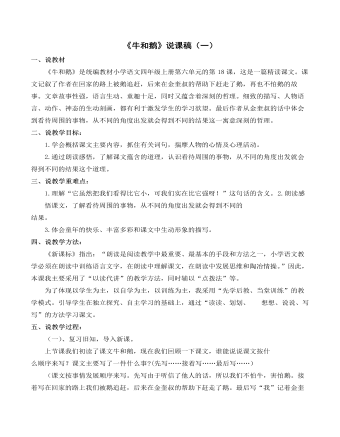
(新)部编人教版四年级上册《牛和鹅》说课稿(一)
二、说教学目标: 1.学会概括课文主要内容,抓住有关词句,揣摩人物的心情及心理活动。2.通过朗读感悟,了解课文蕴含的道理,认识看待周围的事物,从不同的角度出发就会得到不同的结果这个道理。三、说教学重难点:1.理解“它虽然把我们看得比它小,可我们实在比它强呀!”这句话的含义。2.朗读感悟课文,了解看待周围的事物,从不同的角度出发就会得到不同的结果。 3.体会童年的快乐、丰富多彩和课文中生动形象的描写。四、说教学方法: 《新课标》指出:“朗读是阅读教学中最重要、最基本的手段和方法之一,小学语文教学必须在朗读中训练语言文字,在朗读中理解课文,在朗读中发展思维和陶冶情操。”因此,本课我主要采用了“以读代讲”的教学方法,同时辅以“点拨法”等。 为了体现以学生为主,以自学为主,以训练为主,我采用“先学后教、当堂训练”的教学模式。引导学生在独立探究、自主学习的基础上,通过“读读、划划、 想想、说说、写写”的方法学习课文。
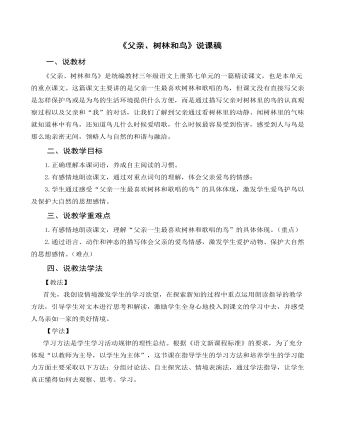
部编人教版三年级上册《父亲、树林和鸟》说课稿
二、说教学目标1.正确理解本课词语,养成自主阅读的习惯。2.有感情地朗读课文,通过对重点词句的理解,体会父亲爱鸟的情感;3.学生通过感受“父亲一生最喜欢树林和歌唱的鸟”的具体体现,激发学生爱鸟护鸟以及保护大自然的思想感情。三、说教学重难点1.有感情地朗读课文,理解“父亲一生最喜欢树林和歌唱的鸟”的具体体现。(重点)2.通过语言、动作和神态的描写体会父亲的爱鸟情感,激发学生爱护动物、保护大自然的思想感情。(难点)四、说教法学法【教法】首先,我创设情境激发学生的学习欲望,在探索新知的过程中重点运用朗读指导的教学方法,引导学生对文本进行思考和解读,激励学生全身心地投入到课文的学习中去,并感受人鸟亲如一家的美好情境。【学法】学习方法是学生学习活动规律的理性总结。根据《语文新课程标准》的要求,为了充分体现“以教师为主导,以学生为主体”,这节课在指导学生的学习方法和培养学生的学习能力方面主要采取以下方法:分组讨论法、自主探究法、情境表演法,通过学法指导,让学生真正懂得如何去观察、思考、学习。
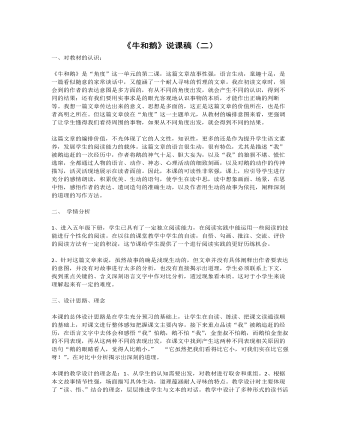
(新)部编人教版四年级上册《 牛和鹅》说课稿(二)
这篇文章的编排价值,不光体现了它的人文性,知识性,更多的还是作为提升学生语文素养,发展学生的阅读能力的载体。这篇文章的语言很生动,很有特色,尤其是描述“我”被鹅追赶的一次经历中,作者将鹅的神气十足、胆大妄为,以及“我”的狼狈不堪、慌忙逃窜,全都通过人物的语言、动作、神态、心理活动的细致刻画,以及对鹅的动作的传神描写,活灵活现地展示在读者面前。因此,本课的可读性非常强,课上,应引导学生进行充分的感情朗读,积累优美、生动的语句,使学生在读中思,读中想象画面、场景,在思中悟,感悟作者的表达、遣词造句的准确生动,以及作者用生动的故事为依托,阐释深刻的道理的写作方法。二、 学情分析1、进入五年级下册,学生已具有了一定独立阅读能力,在阅读实践中能运用一些阅读的技能进行个性化的阅读。在以往的课堂教学中学生的自读,自悟、勾画、批注、交流、评价的阅读方法有一定的积淀,这节课给学生提供了一个进行阅读实践的更好历练机会。2、针对这篇文章来说,虽然故事的确是浅现生动的,但文章并没有具体阐释出作者要表达的意图,并没有对故事进行太多的分析,也没有直接揭示出道理,学生必须联系上下文,找到重点关键的、含义深刻语言文字中作对比分析,透过现象看本质。这对于小学生来说理解起来有一定的难度。
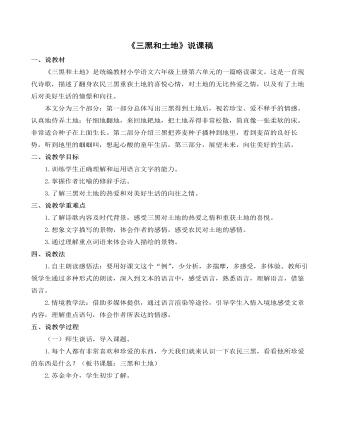
部编人教版六年级上册《三黑和土地》说课稿
一、说教材 《三黑和土地》是统编教材小学语文六年级上册第六单元的一篇略读课文。这是一首现代诗歌,描述了翻身农民三黑重获土地的喜悦心情,对土地的无比热爱之情,以及有了土地后对美好生活的憧憬和向往。 本文分为三个部分:第一部分总体写出三黑得到土地后,视若珍宝、爱不释手的情感。认真地侍弄土地:仔细地翻地,来回地耙地,把土地弄得非常松散,简直像一张柔软的床。非常适合种子在上面生长。第二部分介绍三黑把荞麦种子播种到地里,看到麦苗的良好长势,听到地里的蝈蝈叫,想起心酸的童年生活,第三部分,展望未来,向往美好的生活。 二、说教学目标 1.训练学生正确理解和运用语言文字的能力。 2.掌握作者比喻的修辞手法。 3.了解三黑对土地的热爱和对美好生活的向往之情。
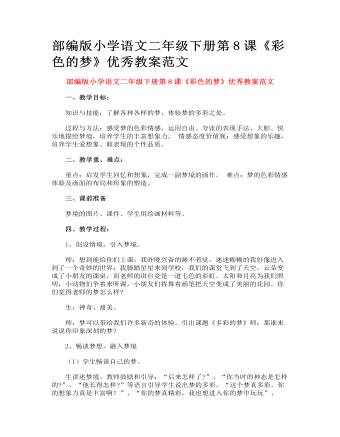
部编版小学语文二年级下册第8课《彩色的梦》优秀教案范文
创设情境,引入梦境。师:想到能给你们上课,我昨晚兴奋的睡不着觉,迷迷糊糊的我好像进入到了一个奇妙的世界:我脚踏星星来到学校,我们的课堂飞到了天空,云朵变成了小朋友的课桌,而老师的讲台竟是一道七色的彩虹。太阳和月亮为我们照明,小动物们争着来听课,小朋友们挥舞着画笔把天空变成了美丽的花园。你们觉得老师的梦怎么样?生:神奇、甜美。师:梦可以带给我们许多新奇的体验。引出课题《多彩的梦》师:那谁来说说你印象深刻的梦?
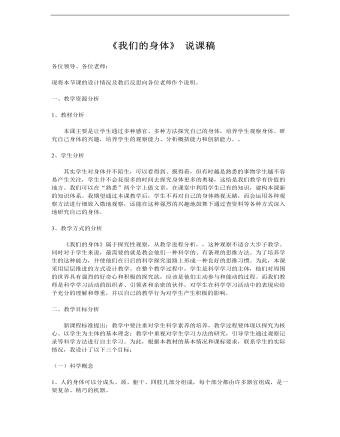
小学科学鄂教版五年级上册《我们的身体》说课稿
2、学生分析 其实学生对身体并不陌生,可以看得到、摸得着,但有时越是熟悉的事物学生越不容易产生关注,学生并不会花很多的时间去探究身体更多的奥秘,这恰是我们教学有价值的地方。我们可以在“熟悉”两个字上做文章,在课堂中利用学生已有的知识,建构本课新的知识体系。我期望通过本课教学后,学生不再对自己的身体熟视无睹,而会运用各种观察方法进行细致入微地观察,还能在这种强烈的兴趣地鼓舞下通过查资料等各种方式深入地研究自己的身体。
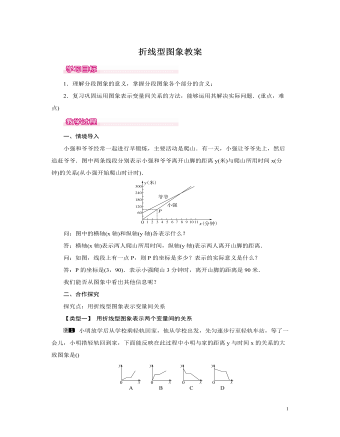
北师大初中七年级数学下册折线型图象教案
解析:(1)根据图象的纵坐标,可得比赛的路程.根据图象的横坐标,可得比赛的结果;(2)根据乙加速后行驶的路程除以加速后的时间,可得答案.解:(1)由纵坐标看出,这次龙舟赛的全程是1000米;由横坐标看出,乙队先到达终点;(2)由图象看出,相遇是在乙加速后,加速后的路程是1000-400=600(米),加速后用的时间是3.8-2.2=1.6(分钟),乙与甲相遇时乙的速度600÷1.6=375(米/分钟).方法总结:解决双图象问题时,正确识别图象,弄清楚两图象所代表的意义,从中挖掘有用的信息,明确实际意义.三、板书设计1.用折线型图象表示变量间关系2.根据折线型图象获取信息解决问题经历一般规律的探索过程,培养学生的抽象思维能力,经历从实际问题中得到关系式这一过程,提升学生的数学应用能力,使学生在探索过程中体验成功的喜悦,树立学习的自信心.体验生活中数学的应用价值,感受数学与人类生活的密切联系,激发学生学数学、用数学的兴趣
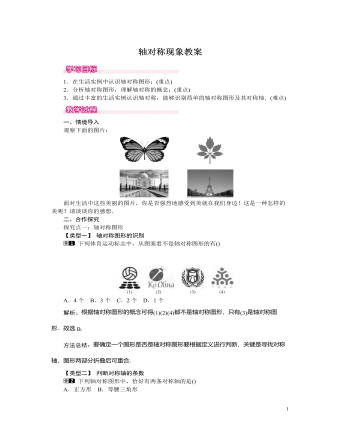
北师大初中七年级数学下册轴对称现象教案
方法总结:判断轴对称的条数,仍然是根据定义进行判断,判断轴对称图形的关键是寻找对称轴,注意不要遗漏.探究点二:两个图形成轴对称如图所示,哪一组的右边图形与左边图形成轴对称?解析:根据轴对称的意义,经过翻折,看两个图形能否完全重合,若能重合,则两个图形成轴对称.解:(4)(5)(6).方法总结:动手操作或结合轴对称的概念展开想象,在脑海中尝试完成一个动态的折叠过程,从而得到结论.三、板书设计1.轴对称图形的定义2.对称轴3.两个图形成轴对称这节课充分利用多媒体教学,给学生以直观指导,主动向学生质疑,促使学生思考与发现,形成认识,独立获取知识和技能.另外,借助多媒体教学给学生创设宽松的学习氛围,使学生在学习中始终保持兴奋、愉悦、渴求思索的心理状态,有利于学生主体性的发挥和创新能力的培养
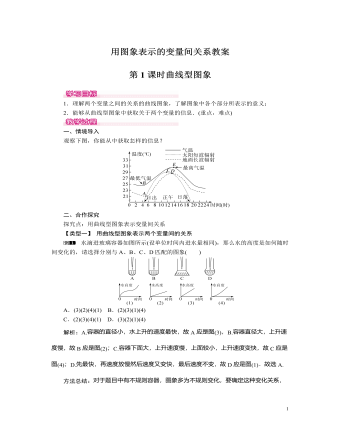
北师大初中七年级数学下册曲线型图象教案
解析:横轴表示时间,纵轴表示温度.温度最高应找到图象的最高点所对应的x值,即15时,A对;温度最低应找到图象的最低点所对应的x值,即3时,B对;这天最高温度与最低温度的差应让前面的两个y值相减,即38-22=16(℃),C错;从图象看出,这天0~3时,15~24时温度在下降,D对.故选C.方法总结:认真观察图象,弄清楚时间是自变量,温度是因变量,然后由图象上的点确定自变量及因变量的对应值.三、板书设计1.用曲线型图象表示变量间关系2.从曲线型图象中获取变量信息图象法能直观形象地表示因变量随自变量变化的变化趋势,可通过图象来研究变量的某些性质,这也是数形结合的优点,但是它也存在感性观察不够准确,画面局限性大的缺点.教学中让学生自己归纳总结,回顾反思,将知识点串连起来,完成对该部分内容的完整认识和意义建构.这对学生在实际情境中根据不同需要选择恰当的方法表示变量间的关系,发展与深化思维能力是大有裨益的
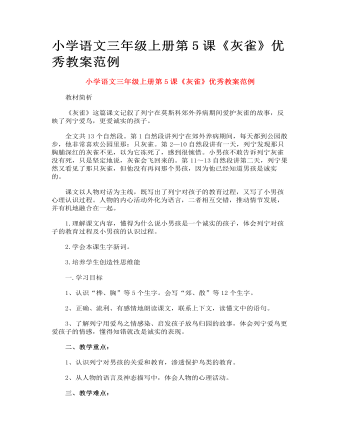
小学语文三年级上册第5课《灰雀》优秀教案范例
教材简析 《灰雀》这篇课文记叙了列宁在莫斯科郊外养病期间爱护灰雀的故事,反映了列宁爱鸟,更爱诚实的孩子。 全文共13个自然段。第1自然段讲列宁在郊外养病期间,每天都到公园散步,他非常喜欢公园里那:只灰雀。第2—10自然段讲有一天,列宁发现那只胸脯深红的灰雀不见,以为它冻死了,感到很惋惜。小男孩不敢告诉列宁灰雀没有死,只是坚定地说,灰雀会飞回来的。第11~13自然段讲第二天,列宁果然又看见了那只灰雀,但他没有再问那个男孩,因为他已经知道男孩是诚实的。 课文以人物对话为主线,既写出了列宁对孩子的教育过程,又写了小男孩心理认识过程。人物的内心活动外化为语言,二者相互交错,推动情节发展,并有机地融合在一起。
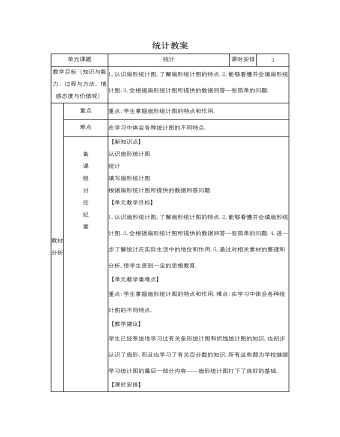
人教版新课标小学数学六年级上册统计教案
【新知识点】认识扇形统计图统计填写扇形统计图根据扇形统计图所提供的数据回答问题【单元教学目标】1,认识扇形统计图,了解扇形统计图的特点.2,能够看懂并会填扇形统计图.3,会根据扇形统计图所提供的数据回答一些简单的问题.4,进一步了解统计在实际生活中的地位和作用.5,通过对相关素材的整理和分析,使学生受到一定的思想教育.【单元教学重难点】重点:学生掌握扇形统计图的特点和作用.难点:在学习中体会各种统计图的不同特点.【教学建议】学生已经系统地学习过有关条形统计图和折线统计图的知识,也初步认识了扇形,而且也学习了有关百分数的知识,所有这些都为学校继续学习统计图的最后一部分内容——扇形统计图打下了良好的基础.【课时安排】
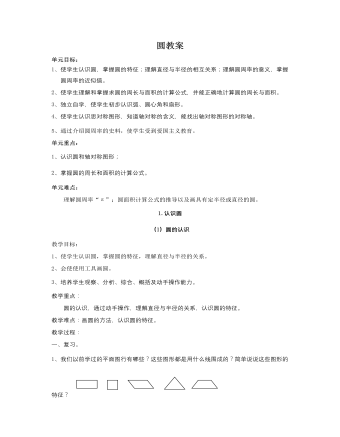
人教版新课标小学数学六年级上册圆教案
教学追记:本堂课,在我带领着学生利用教具进行操作,在此基础上,让学生自主发现圆的面积与拼成长方形面积的关系,圆的周长、半径和长方形的长、宽的关系,并推导出圆的面积计算公式。教学环形的面积计算时,我充分放手给学生,让学生通过思考讨论领悟出求环形的面积是用外圆面积减去内圆面积,并引导他们发现这两种算法的一致性,同时提醒学生尽量使用简便算法,减少计算量。圆的周长和面积的练习课教学目标:1、通过教学使学生理解并掌握圆的周长和面积计算方法。2、培养学生分析问题和解决问题的能力,发展学生的空间观念。3、灵活解答几何图形问题。教学重点:认真审题,分辨求周长或求面积。教学过程:一、复习。1、求出下面圆的周长和面积并用彩笔描出周长,用阴影表示出面积。
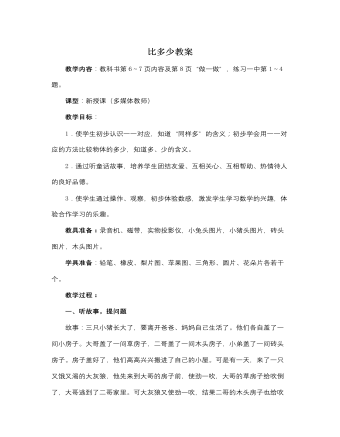
人教版新课标小学数学一年级上册比多少教案
4.操作。(“做一做”第2题) 全班同学动手操作,1名同学到投影仪上操作。 (1)第1行摆5个△,在△下面摆○,△要比○多1个。第2行摆几个○? (2)第1行摆4朵红花,摆的黄花比红花少1朵,第2行摆几朵黄花? 二、运用新知 教科书练习一第1~4题。 1.第1题:左图是猴子多,右图是骨头多。(避免学生产生思维定势) 2.第2题:学生观察,看到公鸡和鸭子虽然摆的一样长,但疏密不同,进而判断摆的密的鸭子的只数多些,而公鸡只数少些。 3.第3题:学生在观察到第一排蛋糕同样多的基础上,只需比较两盒中的第二排。第二排多的就多些,反之,就少些。 4.第4题:此题是在同一排中比较多少,当第5次循环出现珠子时,只出现了一个黄色珠子,所以黄珠子多而红珠子少。 三、总结 教师:今天我们学习了“比一比”,知道在比较时,一定要一个对着一个比,就会得到正确的结果。
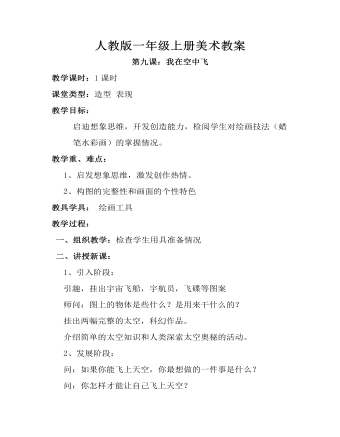
小学美术人教版一年级上册《第9课我在空中飞》教案
一、组织教学:检查学生用具准备情况二、讲授新课:1、引入阶段:引趣,挂出宇宙飞船,宇航员,飞碟等图案师问:图上的物体是些什么?是用来干什么的?挂出两幅完整的太空,科幻作品。介绍简单的太空知识和人类深索太空奥秘的活动。
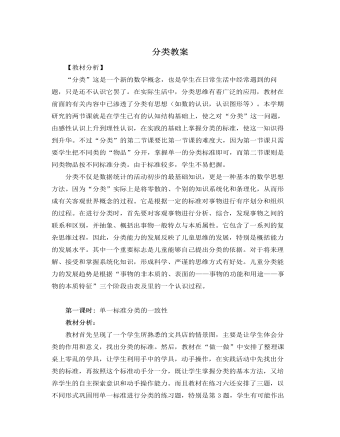
人教版新课标小学数学一年级上册分类教案
教学目标:1.能选择不同的标准对同一类物品进行不同的分类,掌握分类的方法。2.初步感知不同标准分类的意义,体验分类结果在不同标准下的多样性。3.培养学生思维的灵活性和发散性,养成良好的学习、生活习惯。4.培养学生的操作能力、观察能力、判断能力、语言表达能力和合作交流的意识。5.让学生体会到生活中处处有数学,学会用学到的知识解决生活中的实际问题。教学重、难点:重点:选择不同标准分类难点:思维的发散性 关键:在直观中拓展思维的时空教学准备:铅笔、实物卡片、学具袋(各种形状、颜色各异的物品)教学过程:一、观察分析 多重分类1.师出示如书本P39页的铅笔。(1)观察这些铅笔有什么不同?并把它们分分类。(2)四人一小组交流、讨论可以怎么分类?是按什么分的?比比哪一组的分法最多。
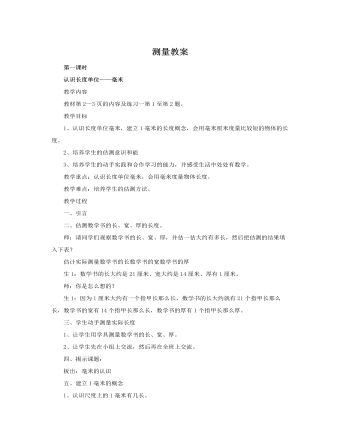
人教版新课标小学数学三年级上册测量教案
教学目标1、认识长度单位毫米,建立1毫米的长度概念,会用毫米厘米度量比较短的物体的长度。2、培养学生的估测意识和能3、培养学生的动手实践和合作学习的能力,并感受生活中处处有数学。教学重点:认识长度单位毫米,会用毫米度量物体长度。教学难点:培养学生的估测方法。教学过程一、引言二、估测数学书的长、宽、厚的长度。师:请同学们观察数学书的长、宽、厚,并估一估大约有多长,然后把估测的结果填入下表?估计实际测量数学书的长数学书的宽数学书的厚生1:数学书的长大约是21厘米、宽大约是14厘米、厚有1厘米。师:你是怎么想的?生1:因为1厘米大约有一个指甲长那么长,数学书的长大约就有21个指甲长那么长,数学书的宽有14个指甲长那么长,数学书的厚有1个指甲长那么厚。

人教版新课标小学数学三年级上册四边形教案
教具、学具准备:各种形状的纸、树叶、绳子、直尺、卷尺等。教学过程:一、今天,老师给大家带来了一些物品和平面图形,你们认识吗?(逐一出示)谁知道周长是什么意思?请你具体指一指,你所喜欢的图形的周长是指什么样的长度。(一生指)二、探究求长方形和正方形周长的计算方法长方形和正方形的周长怎么求呢?正方形的周长只要量一条边长,乘4就可以了。(板书:边长×4)如果量出正方形的边长是5厘米,它的周长是多少?5×4=20(厘米)。长方形的周长呢?量出四条边的长度,加起来就好了。长+宽+长+宽(板书)。如果长是6厘米,宽是4厘米,它的周长就是:6+4+6+4=20(厘米)。只要量两次就可以了,量一个长再乘2,量一个宽再乘2就行。长×2+宽×2。即:6×2+4×2=20(厘米)。如果让你求长方形的周长,必须要知道什么条件?正方形呢?想清楚了,我们来解决一些实际问题。
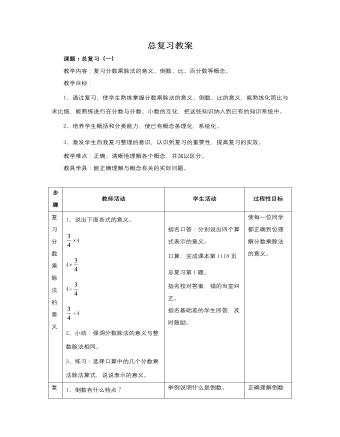
人教版新课标小学数学六年级上册总复习教案
出示:1、某校有男生500人,女生有450人,女生是男生的百分之几?你能把这道题改编成另外二道一步计算的百分数应用题吗?2、某校有男生500人,女生人数是男生的90%,女生有多少人?3、某校有女生450人,是男生的90%,男生有多少人?师:你觉得这三题有什么相同的地方和不同的地方?同:都以男生的人数为单位“1”异:条件与问题不同出示:1、完成书本124页第14题。2、2000年我国农村居民人均纯收入为2253元,1999年为2210元。2000年比1999年增长百分之几?3、一本书有240页,小林第一天看了 ,第二天看了12.5%,第三天应该从第几页看起?4、边长1厘米的正方形面积比边长2厘米的正方形面积少百分之几?5、修一条公路,实际造价84万元,比原计划增加了5%,增加了多少万元?出示:1、花园小学五年级男生有150人,女生人数是男生的 ,已知五年级人数占全校学生人数的25%。全校有多少名学生?2、书本124页第15、16、17题。
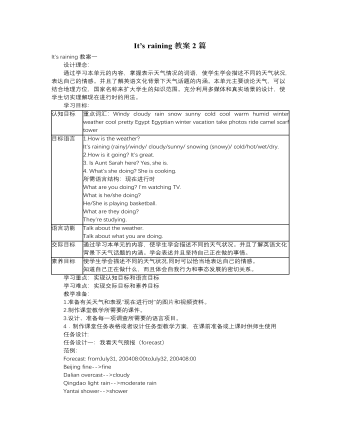
人教版新目标初中英语七年级下册It’s raining教案2篇
1 Each group choose one place to describe and what you are doing in it Choose one place, and describe what they are doing 2 Move around the room and give suggestions Talk about it and write it down 3 Ask one to show their works and act it Choose one of each group to make a report 4 Evaluate the best group and the best reporter Choose the best one Homework Ask your friends their ideal place and write about it教学反思:新课程标准中强调学生在课堂中的主体地位,在综合课中他们的主体地位就更加突出。在各个活动中给不同程度的学生不同层次的任务,让各层面的学生都有表现发挥的机会,从而产生对英语的兴趣。使用照片图片多媒体来辅助教学,效果更好。同时让了解其他国家风景,风俗的同学介绍ideal place,增加学生的背景知知识,实现跨学科交流的目的。教案点评:采用任务型教学模式,在各个活动中给不同程度的学生不同层次的任务,让各层面的学生都有表现发挥的机会,从而产生对英语的兴趣。使用照片图片多媒体来辅助教学,效果更好。让了解其他国家风景,风俗的同学介绍ideal place,增加学生的背景知识,实现跨学科交流的目的。
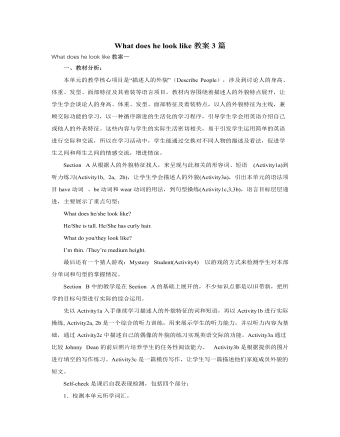
人教版新目标初中英语七年级下册What does he look like教案3篇
所需要用到的句子:Who is that?That is Jack. I like him.Why do you like him?I like him because he is interesting.Task 4: 设计理想中的人类Step one: 设计理想中的人类的外貌。把全班同学分成若干小组,学生可以边说边在纸上画出他们的模样。Step two: 设计理想中人类的性格。学生们可以把那些能描述性格的单词写在图画的旁边。Step three: 每组选出一名同学,其他同组同学提问,他作简单回答,并说明原因。所需用到的句子:What does he or she look like?He or she ...What is he or she like?He or she is ...Why?Because ...Task 5: 挑战性活动调查性格是天生的还是后天形成的,让每个同学回家去调查一下自己成长过程中性格是否有变化,具体是怎样的,为什么会这样? Teaching Aims:1. Enable students to have a general understanding of how to talk about people's physical appearance.2. Enable students to tackle some essential vocabularies and patterns about describing people. Provide them with necessary skills and methods.3. Create various chances for students to describe the persons they're familiar with, such as classmates, family members, teachers, idols, etc.

